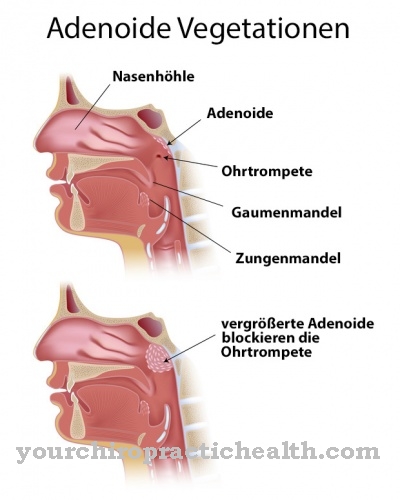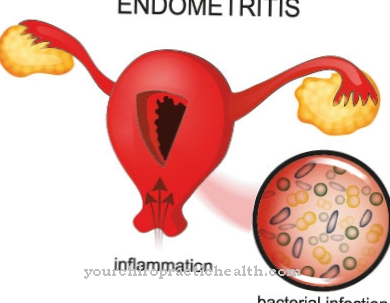Depending on the pregnant woman, a Polyhydramnios take different forms. Medical treatment is not always necessary.
What is polyhydramnios?

© Prostock-studio - stock.adobe.com
A Polyhydramnios (also as Hydramnios or Polyhydramnios when a pregnant woman has an above-average amount of amniotic fluid.
The amount of amniotic fluid from which a polyhydramnios is referred to in medicine is based, among other things, on the so-called amniotic fluid index (AFI) - if this index exceeds a value of 20 cm in a pregnant woman, then according to the medical definition, there is an above-average amount of amniotic fluid. Another characteristic value for an existing polyhydramnios is an amniotic fluid volume of more than 2 liters on the due date.
Often times, polyhydramnios is associated with an enlarged abdomen in the pregnant woman and consistent fluid movements in the uterus (uterus). The heartbeat of the unborn child may be weakened. Polyhydramnios occur in about 1 - 3% of all pregnancies.
causes
Possible causes of a Polyhydramnios can be found in both the fetus and the expectant mother.
One of the possible causes of an increased amount of amniotic fluid on the mother's side is an existing diabetes mellitus disease (also known as diabetes): In the fetus, the mother's sugar disease can lead to so-called polyuria, i.e. increased production of urine. As a result, polyhydramnios develops. Diseases such as syphilis in a pregnant woman can also promote polyhydramnios.
In the unborn child, for example, heart defects or various infections can cause polyhydramnios to occur. Malformations of the gastrointestinal tract, developmental disorders of the cerebrum, bone formation disorders, chromosomal abnormalities or a cleft lip and palate in the fetus occasionally lead to an increased amount of amniotic fluid in the uterus. Finally, polyhydramnios can also be favored if an embryo does not take in any or too little amniotic fluid through drinking.
Symptoms, ailments & signs
In a so-called polyhydramnios, the amount of amniotic fluid in the amnion is greater than two liters. In around three percent of all pregnancies, this condition can occur before the 37th week of pregnancy. This can result in complications for both the mother and the child.
Polyhydramnios manifests itself in persistent pelvic pain, severe abdominal tension, labor, pulling in the lower abdomen, shortness of breath and dizziness. Various pregnancy symptoms such as indigestion, constipation, heartburn, swollen legs, varicose veins or stretch marks increase. Since polyhydramnios can be caused by different diseases, other symptoms are possible, but they point to the underlying disorder.
In addition, there is a weakening of the child's heartbeat. If these symptoms appear in the 37th week of pregnancy, there are many indications of polyhydramnios. Emergency treatment should be initiated immediately to avoid complications for both mother and child. Symptoms such as placental rupture, premature rupture of the bladder, umbilical cord protrusion or an unusual cessation of childbirth are possible complications.
Furthermore, increased blood pressure can develop in the mother as a result of the increased amount of amniotic fluid. It also increases the risk of urinary tract infections. The child is at risk of premature birth. If necessary, the birth must be initiated by a caesarean section as early as the 37th week of pregnancy. The child's birth weight may be reduced. In extreme cases, infant death occurs.
Diagnosis & course
Is diagnosed a Polyhydramnios mostly using sonography (an imaging technique based on ultrasound). The amount of amniotic fluid can be determined, for example according to the criteria of the AFI, on the basis of the images of the abdomen of an expectant mother made in this way.
For this purpose, the abdomen shown is first divided into four quadrants (quarters). The largest amniotic fluid depots in each quadrant are now summed up and can thus provide information about a polyhydramnios present.
If a polyhydramnios does not resolve itself or is treated accordingly, various complications can arise in the course of pregnancy. For example, polyhydramnios can promote premature tearing of the amniotic sac. As a result of polyhydramnios, for example, umbilical cord prolapse (an umbilical cord prolapse) on the part of the expectant mother or the placenta (the placenta) rupture. Last but not least, an increased amount of amniotic fluid occasionally impairs a suitable child position.
Complications
Polyhydramnios can make themselves felt in various symptoms. However, symptoms and complications vary widely in most women, so it is usually not possible to make a general prediction. The waist size of those affected increases considerably and the skin around the stomach becomes very tense.
The patient's resilience also drops significantly due to the polyhydramnios, causing breathing difficulties and, among other things, shortness of breath. Furthermore, those affected often suffer from heartburn or abdominal pain. The polyhydramnios also lead to constipation and general digestive problems or stomach pain. The patient's quality of life is severely impaired by this disease.
Due to the swollen legs, the patients sometimes suffer from restricted mobility and not infrequently also have varicose veins. The polyhydramnios does not have to be treated in every case. In most cases, the symptoms go away on their own, so that there are no particular complications. Surgical interventions are rarely necessary. However, the life of the mother and child is not endangered.
Treatment & Therapy
Not always a must Polyhydramnios receive medical treatment; An increased amount of amniotic fluid can also regress on its own in various cases. If there is no independent regression of the amniotic fluid, a so-called amniotic fluid discharge puncture is carried out in various cases of pronounced polyhydramnios.
As part of such an operation, a hollow needle is inserted into the amniotic sac; In further treatment steps, excess amniotic fluid can now be drained. Alternatively, polyhydramnios can also be treated with medication; in this case, active ingredients are usually used that have an inhibiting effect on the production of amniotic fluid.
Whether an existing polyhydramnios needs treatment and which therapeutic measures are used if necessary depends, among other things, on factors such as the extent of a polyhydramnios and the state of health of the embryo and the mother-to-be. If a polyhydramnios is caused by diseases of the mother, the possible elimination of excess amniotic fluid is often accompanied by therapeutic measures that target the underlying disease.
prevention
Since in many cases the causes of a Polyhydramnios cannot be clearly diagnosed, an appropriate prevention is hardly possible. If an expectant mother is aware of her own metabolic diseases such as diabetes mellitus, consistent treatment of the underlying disease can reduce the risk of polyhydramnios; Suitable steps can be requested from the treating doctor, for example.
Aftercare
In most cases, the affected person has only a few and only limited follow-up measures available. For this reason, a doctor must be consulted at an early stage with this disease so that there are no further complications or complaints that could reduce the quality of life of the person affected. Treatment of the disease cannot always be carried out, although it is not always necessary.
In many cases the symptoms can resolve on their own, although permanent monitoring by a doctor is very important in order to detect complications and other complaints at an early stage. The child should also be checked regularly after the successful birth to ensure normal development of the child.
In most cases there will be no further complications or complaints. If there is a miscarriage, those affected are dependent on intensive psychological support. Above all, the support of one's own family has a very positive effect on the further course of the disease. Further follow-up measures are usually not available to those affected by polyhydramnios.
You can do that yourself
If the waist circumference is abnormally large during pregnancy, a doctor should be consulted. If polyhydramnios is present, the woman should refrain from exercising and watch carefully for any unusual symptoms. Treatment is only necessary if there is an acute danger to the baby. Therefore, no further measures need to be taken initially.
However, if pain or other complaints arise, medical advice is required. Affected women can survive a puncture of the abdomen better by avoiding heavy foods before the procedure. After the procedure, you should rest for a few days. The amniotic sac needs to relax to prevent complications during labor. Affected women can alleviate the symptoms after a procedure by drinking soothing teas, getting a professional massage and, most importantly, getting plenty of rest.
If the discomfort does not subside, the gynecologist must prescribe a suitable drug and perform another ultrasound examination. However, polyhydramnios usually proceed without major complications. In many cases, the excess of amniotic fluid does not need treatment.



.jpg)


.jpg)

















.jpg)



